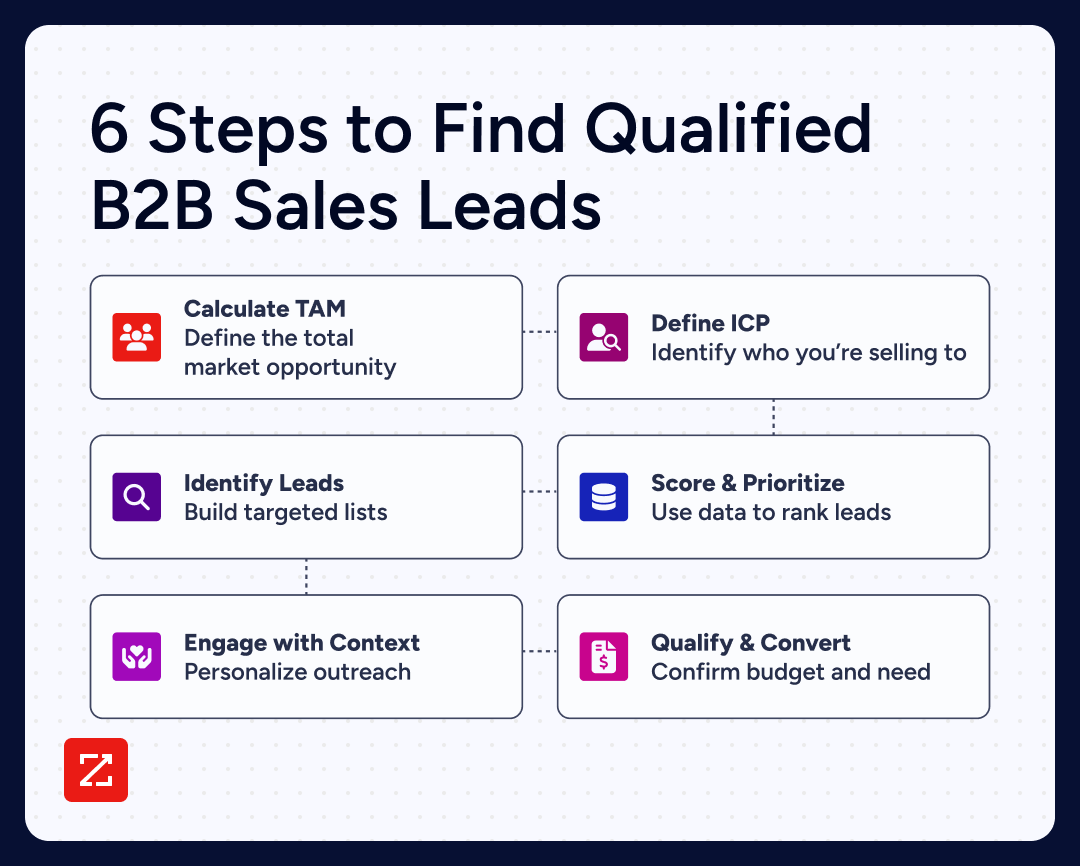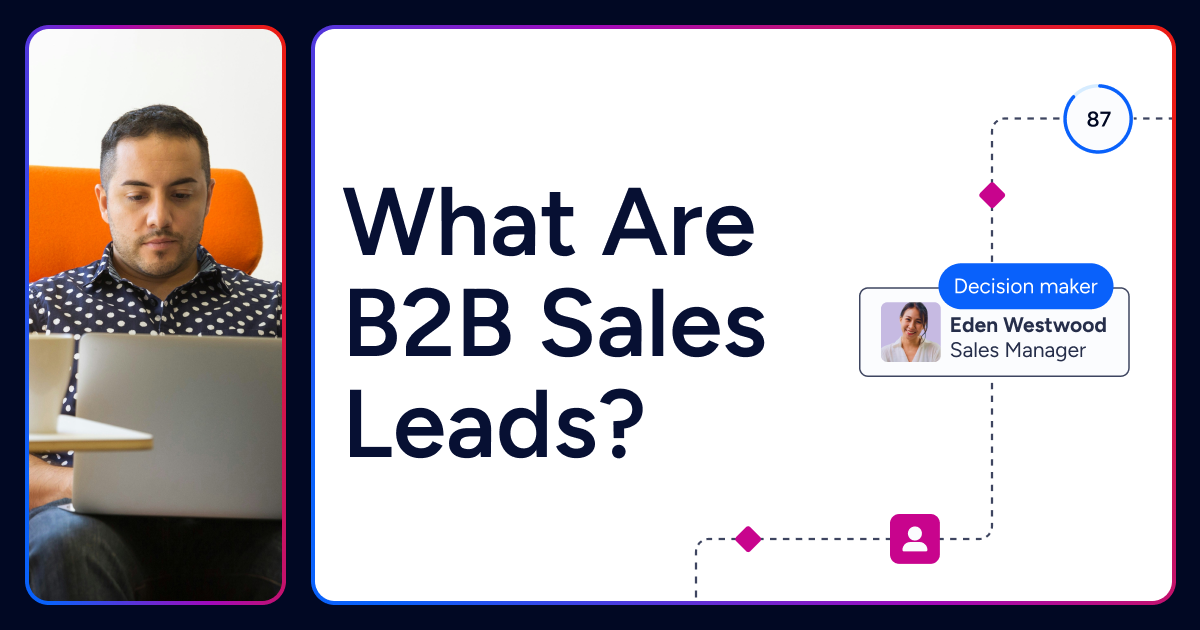Without a steady stream of high-quality B2B sales leads, even the best sales team stalls. But with the rise of AI, decision-makers are often flooded with generic outreach, making it harder to break through the noise and shorten the constantly expanding buying journey.
The solution? Sales teams need smarter, more strategic ways to identify, engage, and convert the right sales leads.
Whether you’re building a B2B sales pipeline from scratch or looking to refine your approach, this guide will help you work more efficiently and sell more effectively.
Understanding B2B Sales Leads
What Are B2B Sales Leads?
A B2B sales lead is a potential buyer: a company or decision-maker who could benefit from your product or service.
However your B2B sales leads are sourced or identified, the priority must be on data quality and accuracy – otherwise, sales teams waste precious time that competitors are leveraging to pull ahead.
B2B vs. B2C Leads: Key Differences
B2B sales leads often involve higher stakes, longer timelines, and multiple decision-makers, when compared to B2C leads. A B2C purchase might take minutes; a B2B deal could take months and require buy-in from multiple stakeholders. That’s why your lead generation and qualification processes must be built for scale, sophistication, and precision.
Inbound vs. Outbound Sales Leads in B2B
Inbound marketing can generate some leads, but it’s not always enough — and those leads are often passive, unpredictable, and of mixed quality. Someone might download an ebook or attend a webinar out of curiosity rather than a real intent to buy. And while these leads are valuable, especially at scale, they don’t always align with your ICP or show strong buying signals.
That’s why high-performing sales teams often take control of the pipeline through outbound strategies. Outbound sales empowers reps to go directly after high-value accounts and targeted personas that match their ICP. Instead of relying on someone to fill out a form, reps can proactively identify the right buyers, personalize outreach based on real-time data and signals, and engage decision-makers when they’re most likely to act.
This precision is especially important in B2B sales, where deals are complex, stakeholders are numerous, and timing is everything.
With a Go-to-Market Intelligence Platform like ZoomInfo, reps don’t have to wait for hand-raisers. Instead, you can surface accounts that show buying signals like recent funding or executive changes and get the insights you need to start conversations that convert.
Why Quality Matters More Than Quantity
In B2B, more isn’t always better. A long list of business-to-business leads may look impressive, but if they’re not properly qualified, you’ll spend more time chasing dead ends than closing deals. Successful sales teams focus on lead quality, prioritizing leads that match their ICP, show buying intent, and are in the right stage of the buyer’s journey.
The B2B Sales Lead Generation Process

Where Do Qualified B2B Sales Leads Come From?
If you’ve ever wondered how to find quality B2B sales leads, the answer starts with a strategic process:
Top Strategies for Generating B2B Sales Leads
Signal-Based Lead Generation: The Modern Sales Advantage
Traditional sales lead generation often relies on static criteria like industry, company size, or job title to build lists and prioritize outreach. But what a company is doing right now can be far more valuable than what a company is on paper.
That’s where signal-based lead generation comes in. Buying signals are real-world activities that indicate a company may be entering a buying cycle or experiencing a pain point your solution can solve.
These can include things like:
Executive team changes (e.g. a new CMO or CRO)
Job postings that suggest a department is growing
Recent funding announcements
Expansion into new markets or locations
Changes in technology stacks or digital strategy
Public statements in earnings calls or on podcasts
These signals provide crucial context that helps you pinpoint the “why now” moment and craft timely, relevant outreach that speaks directly to the challenges or goals a company is likely facing.
Used effectively, signals don’t just improve targeting, but transform the way sales teams prioritize, personalize, and position themselves in the market.
Sales Outreach Strategy: Timing Buyer Readiness
Effective lead generation is about more than persistence — it’s about timing. The best time to contact a lead is when a change or trigger event suggests they’re open to new solutions.
For example:
A new VP of sales is likely reassessing vendors.
A company expanding its sales team may need enablement software.
A spike in job openings can signal an upcoming tech investment.
That’s what makes signal-based selling so powerful: timeliness. Instead of relying on guesswork or waiting for prospects to express interest, sellers can get ahead of the curve, engaging buyers at the earliest signs of need — often before competitors even know there’s an opportunity.
Our AI-fueled ZoomInfo Copilot proactively surfaces these moments inside your workflow, letting you know exactly when to engage and what to say based on signals. By aligning your contact efforts with these peak periods, you can ensure that your message reaches decision-makers when they are most receptive.
Relationship Building for B2B Sales
Not every lead comes from a sales tool. Old-school methods for finding business-to-business leads are still valuable, too.
Personal referrals often carry more trust and convert faster since they come with built-in credibility. Industry events, whether virtual or in-person, create space for organic conversations that can lead to warm leads down the line. And with social selling on platforms such as LinkedIn, thoughtful engagement — like commenting on posts or sharing relevant insights — can spark meaningful connections without a hard pitch.
When sellers prioritize relationships, they build a pipeline rooted in trust and relevance.
Buying B2B Sales Leads
Sometimes you have to spend money to make money. Buying B2B sales leads is a strategic way to fill your pipeline faster and jumpstart growth — but only if you know what to look for.
Not all lead providers are created equal, and purchasing low-quality or outdated leads can cost more in wasted time than it’s worth. The key is to evaluate lead sources based on data quality, relevance, and support for your sales goals.
How to Buy B2B Sales Leads the Right Way
When evaluating vendors or platforms, look for the following:
Data Accuracy and Freshness: Make sure leads are up-to-date with verified contact info. Outdated phone numbers or job titles quickly erode trust and productivity.
Firmographic and Technographic Filters: Choose providers that let you filter by industry, company size, revenue, tech stack, and geography to align with your ICP.
Contact-Level Details: Look for rich profiles that include job titles, seniority level, and direct contact information — not just generic info. You need data that can help you discern between gatekeepers and decision-makers.
Intent and Signal Data: Leads are more valuable when paired with context. Make sure the lead provider you choose includes access to real-time signals like leadership changes or funding to help you prioritize and personalize outreach.
Compliance and Consent: Ensure the provider follows data privacy regulations (like GDPR and CCPA) and sources data ethically and transparently.
Integration with Your Tools: Seamless integration with your CRM, sales engagement platform, or automation tools is essential to operationalizing lead data quickly.
Lead Volume vs. Quality Balance: More potential leads doesn’t always mean better. Prioritize vendors that emphasize match quality, signal strength, and fit — especially for complex B2B sales.
Customer Support and Data Services: Look for providers who offer onboarding help, ongoing account support, and the ability to enrich or clean your existing lead data.
By focusing on these criteria, you can buy B2B sales leads that are not only easier to reach, but more likely to convert. A great lead isn’t just a name on a list; it’s a well-matched opportunity backed by context, quality, and timing.
B2B Sales Lead Generation Tools & Technology
Data Intelligence: The Secret Weapon for Smarter Targeting
It’s not enough to build B2B sales leads lists — you need to know which ones are worth pursuing. That’s where data intelligence becomes crucial.
Data is the backbone of effective lead generation. With insights into firmographics, technographics, buyer behavior, and more, sales teams can engage more strategically.
Using a comprehensive Go-to-Market Intelligence Platform like ZoomInfo gives you:
A unified view of accounts and decision-makers
Trigger-based alerts to new buying signals
AI-driven lead recommendations aligned with your ICP
These capabilities ensure that every touchpoint is informed and intentional, reducing wasted effort and increasing pipeline velocity.
CRM Systems: Managing the Lifecycle of Your Leads
A modern customer relationship management (CRM) system does more than store contact information. It acts as a central hub for sales activity, tracking lead sources, engagement history, and pipeline stages. It provides clear visibility into pipeline progress and forecasting and helps you determine the most high-value leads.
But here’s the catch: CRMs are only as good as the data they hold. Outdated records lead to missed opportunities and wasted outreach. It’s important to keep up with CRM data hygiene to make sure all your B2B sales leads remain accurate.
Sales Automation Tools: Outreach at Scale
Email sequencing platforms like Salesloft or Outreach allow you to scale your communication, automating follow-ups to your business-to-business leads while maintaining a personal touch. Combine that with sales intelligence, and you can send targeted, persona-based messages driven by real-time signals.
Benefits include:
Pre-built cadences triggered by buying signals
Multichannel outreach (email, phone, social) at scale
Dynamic personalization based on real-time data
Smart automation is about enhancing the human element, not replacing it. The end result is more consistent follow-up, better timing, and higher conversion rates.
Nurturing B2B Sales Leads for Conversion
The Power of Persistent, Personalized Follow-Up
Consistent follow-up is critical in B2B sales. Many leads won’t convert after a single touch, and often they aren’t ready to buy right away.
Your job is to stay in touch and continue adding value. It typically takes 8 to 12 touches to convert a B2B lead into an opportunity.
As you continue to nurture your leads, set follow-up intervals based on lead behavior, deliver value in every message, and personalize your messaging based on the data and signals available to you.
Use Content That Speaks to the Individual
People respond to relevance, and personalized content builds trust. If your outreach sounds generic, it gets ignored.
But messaging that reflects a lead’s current challenges, industry trends, or recent relevant signal activity earns attention.
Sales personalization should evolve as your B2B lead progresses from awareness to consideration to decision.
Track Engagement and Buyer Intent in Real Time
Lead nurturing is most effective when backed by data. Track interactions to understand when and how to follow up.
Use engagement data like email clicks, document views, and website visits to:
Score leads based on activity level
Segment leads for tailored campaigns
Align sales and marketing on when to escalate handoffs
When you track engagement, you can prioritize the warmest leads and fine-tune your outreach.
Measuring Success: Key Metrics for B2B Sales Lead Generation
You can’t improve what you don’t measure.
Here are key performance indicators (KPIs) every B2B sales team should track:
Lead volume: Number of new leads generated within a period
Lead-to-opportunity rate: How many leads progress into real sales conversations
Lead quality score: A metric based on ICP fit and behavioral signals
Sales cycle length: Average time to move a lead to close
Pipeline contribution: Total pipeline revenue attributed to lead generation efforts
These metrics assess effectiveness to help determine how to allocate resources and guide strategic decisions.
Analyze Conversion to Optimize Results
Analyzing lead data reveals patterns that can drive exponential improvements.
Dig deeper into your performance by analyzing which lead sources, signals, and outreach tactics produce the best results. Do leads with funding signals convert faster? Are certain industries more responsive? Which signals correlate with the highest close rates?
Turn insights into action by refining your lead scoring models, adjusting outreach timing, and doubling down on high-performing strategies.
Find Leads Smarter, Close Faster
Generating B2B sales leads is no longer about blasting cold email lists or relying on chance. Today’s top sellers use timing, intelligence, and personalization to connect with buyers who are ready to act.
With ZoomInfo, you can:
Pinpoint the right business to business leads
Uncover real-time buying signals
Engage with personalization at scale
Optimize engagement and outcomes
Build a scalable, repeatable pipeline
Whether you’re looking to improve your B2B sales lead generation strategy or revamp your entire outbound playbook, ZoomInfo gives you the tools and intelligence to lead with confidence. Discover how ZoomInfo helps sales teams uncover real-time signals, identify decision-makers, and close deals faster.


